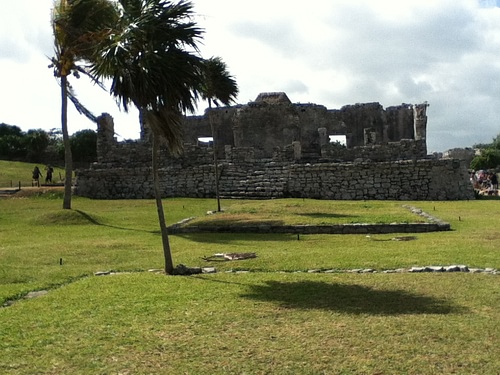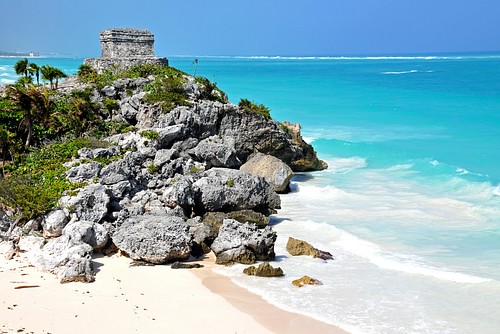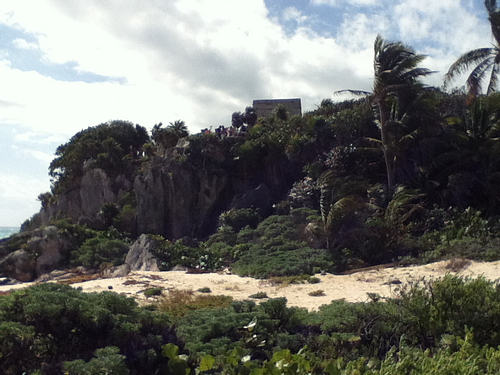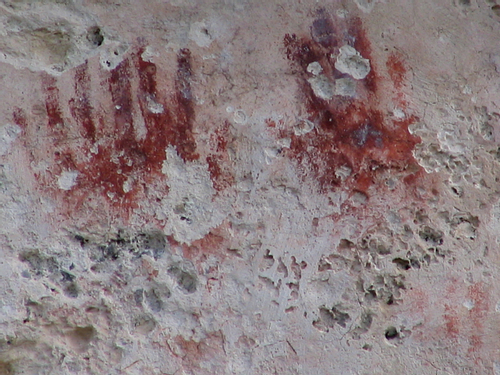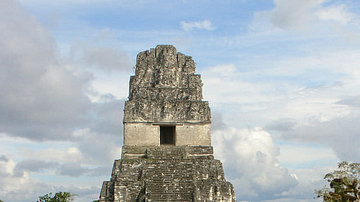The Maya sites of San Gervasio (on the island of Cozumel) and Tulum (on the mainland of Mexico in Quintana Roo) are often overlooked for the better-known Chichen Itza or other spectacular ruins further inland but both these locations have their own vibrant story to tell and each will reward a long, leisurely, visit.
I am walking with Betsy and Emily, my wife and daughter, down the sacred way (sacbe) of San Gervasio on Cozumel on this latest adventure. This is a quick side-trip on our way to the ancient city of Tulum but I am already wishing I had given it more time.

In the past, the city was called Tantun Cuzamil (Flat Rock in the Place of the Swallows) and had great religious significance. It would remain an important place of pilgrimage for women coming to worship the goddess Ix Chel (the “rainbow goddess” and pronounced ee-shell) for centuries, even after the arrival of the Spanish Christians who would rename it according to their religion and replace Ix Chel with the Virgin Mary.
For thousands of years, women would gather on the beaches of Playa del Carmen, 29 miles (48 km) across the water and be rowed to this site by expert oarsmen who could navigate through the rough waves and winds. The trip took twelve hours and, upon arrival, the pilgrims would walk up from the sea to the sacred city to offer prayers and seek divine counsel.
Tantun Cuzamil & the Red Hands
Ix Chel was the goddess of fertility, childbirth, women, weaving, health and medicine, and the moon. Women were expected to make a pilgrimage to honor her here at least once in their lives and, at other times, to send tribute. A pilgrimage to Tantun Cuzamil held the same significance for the Maya as a Christian's to Jerusalem or Rome or along the Camino de Santiago de Compostela, or a Muslim's to Mecca.
At the top of the pyramid up ahead, known as Ka'na Nah (the Tall House), there is a small temple where the oracle spoke to the people. A hollow statue of Ix Chel was once the focal point of this temple and a priestess, light-headed with hallucinogens and purified as a medium, would be installed inside it to channel the goddess. Pilgrims would leave their gifts of food, flowers, and other valuables in thanks for answered prayers.
According to some scholars, it is possible they left permanent records of their visit in red handprints on the walls of another house here, Las Manitas (Little Hands) which was the home of the ruler of Cozumel. This theory is contested, however, as the handprints are also believed to be those of a god. Red handprints can be found on the walls of a number of Maya sites and are associated with the creator god Itzamna whose seven-fingered hands were red-hot to facilitate healing and who, naturally, became associated with doctors.
The red handprints are also connected with another deity, the Descending God, whose nature and role is debated but was linked to Venus. These same kinds of handprints can be seen on the Temple of the Frescoes at Tulum, and I once tried to get inside the Akab Dzib at Chichen Itza to see the same there. I failed at that one as I was chased out by an iguana, so it is a pleasant surprise to be able to see them here.

The only site I know of which has seven-fingered prints is Tulum, where they are high on an exterior wall. The prints here are five-fingered at about the height of an average adult. The prints are remarkably clear for their age. I do not believe they were left by a god; they seem very human.
Off to Tulum
I would love to explore further but we have a boat to catch and so hurry back to the port. We leave Cozumel on a small high-speed ferry which pounds over the rough waters, lurching and bouncing. The speed of the ferry and the high waves of the early morning soon leads to the inevitable result of over half the passengers becoming seasick. The three of us, fortunately, have been on worse waters and are unaffected, but I feel bad for everyone starting their journey this way. If you are at all prone to seasickness, I definitely suggest taking something before boarding that ferry.
The Maya did not have high-speed boats but would have followed approximately the same course we have in leaving Cozumel for the mainland. Besides being an important religious site, Tantun Cuzamil was also part of an extensive trade network with boats leaving regularly laden with goods going up and down the coast.
It only takes us 30 minutes to cross when the captain seems to suddenly realize the pier of the mainland is directly ahead and, with a sudden lurch and a shudder, we slow and cruise quietly in. Once docked, we are met by our guide, Antonio, and his driver, who lead us and seven others through the winding streets to their small van.
Antonio points out Maya-related sites along the way and brings us through the outskirts of the Zona Arqueologica Playa del Carmen. These are modest Maya ruins but still fascinating and full of wildlife with small capybaras and agoutis scampering about. This would have been another trade center the Maya from Cozumel would have probably stopped at before getting back in their boats and making their way down to Tulum. We will not be taking that route; we will be going overland and, after the boat ride, I am glad of it.
The van trip, however, turns out to be almost as harrowing as the ferry ride, and I have to suspect the driver has taken lessons from the captain. We all survive, though, and climb down onto the parking lot outside the Tulum gift shop. Antonio is friendly and easy-going but firm in handling his guests here and hurries us away from the stalls and shops and onto the dirt path.
It is a bright day with a cloudless blue sky above and a soft breeze. It is about a 10-minute walk on a flat trail, then up a slight hill, the jungle rising on either side and the sun high overhead. We pass through the ticket booth, climb higher on the trail, until an ancient stone wall emerges from the tangled growth of roots and vines on our right.
We follow the old wall as it curves toward an arch and step out of the bright sunlight into a short corridor, dark and cool and damp, and then the sunlight is suddenly blinding as we come out the other side into the ancient city of Tulum.
Tulum
Far across an expanse of green grass and pale, weathered, ruins rises the famous pyramid of El Castillo and over to the far left below it is the Temple of the Descending God and way over toward the right at the corner is the Temple of the Frescoes and, for a moment, I am just stunned. I am like a child at the carnival who cannot decide which ride to go on first.
My problem is solved when Antonio gestures for us to follow him. We move toward the right as he begins talking about the history of the city and leads us toward a low wall of stone and down a path, flanked by the ruins of ancient buildings, toward the Temple of the Frescoes. The energy of the place is so vibrant the earth beneath my feet feels like it is singing. I feel confident it has always had this same magic to it and this is probably why the Maya chose the site for their city.

Tulum first came to the world's attention in the mid-19th century CE when John Lloyd Stephens and Frederic Catherwood popularized the Maya culture in their books Travel in Central America, Chiapas, and Yucatan (1841 CE) and Incidents of Travel in Yucatan (1843 CE), two best-selling narratives of their explorations of ancient Maya sites. Almost all of the Maya cities had been steadily swallowed by the surrounding jungle since their abandonment c. 950 CE, but Tulum was a late city, still occupied and operating as a trade center in 1518 CE when the Spanish arrived.
Built on a cliff 39 feet (12 m) above the sea, and surrounded on the other three sides by a wall 16 feet (5 m) thick, Tulum was already thriving as a trade center by the 6th century CE. Its original name may have been Zama (City of the Dawn), and it was a ceremonial/religious site from at least 1200 CE until the Spanish Conquest in the 16th century CE. The present name Tulum means 'wall' or 'fence' and is a later designation.
Most Maya cities were not walled in the Classic Period - which saw the rise of centers like Chichen Itza - but Tulum is a later site and, like the wealthy city of Mayapan to the north-west, was walled to protect against attacks from others. The significant thickness of Tulum's wall, as well as its position atop the cliff, suggests that the site held special significance for the people and its meaning was religious. Tulum's central temple (El Castillo) would have caught the first rays of the sun each morning, illuminating its interior at the top of the steps, and welcoming the god Kukulcan to another day on the earth he helped create.
Maya Creation Narrative
According to the Maya religion, at the beginning of time, there was nothing. The Quiche Maya sacred text, the Popol Vuh, describes the world before the gods chose to create order:
Only the sky alone is there...only the sea alone is pooled under all the sky; there is nothing whatever gathered together. Whatever might be is simply not there: only murmurs, ripples, in the dark, in the night. (Tedlock, 64)
Within the waters swam the great plumed serpent, Kukulkan (identified with Itzamna), and high above flew the god Hunab Ku (also known as Heart of Sky). In some myths, Itzamna, in his serpent form, is the son of Hunab Ku. The two gods understood each other's thoughts, and Hunab Ku flew down at the same time the great Plumed Serpent swam up, and they conferred and recognized what they had to do. They spoke existence into creation magically:
For the forming of the earth, they said 'Earth' and it arose suddenly, just like a cloud, like a mist, now forming, unfolding. (Tedlock, 65)
Their creation was not instantly perfect. The world, and everything in it, had to be created and destroyed four times before the reality matched their vision. During one of these times, the rain fell too hard and for too long and soaked the sky so thoroughly that it collapsed onto the earth. The gods then created the four-fold supernatural entities known as the Bacabs who stand at the earth's corners (the four cardinal points) and hold up the sky up so it will never fall again.
In another attempt at creation, the people the gods made were so terrible to each other, animals, nature, and their creators that the deities turned them over to the creatures and objects they had abused. Dogs were given the power of speech and turned on their masters. Cooking pots, knives, hoes came to life, accused, and attacked. Once these humans were destroyed, the gods made new and better ones from corn. The Maize God, a fertility deity also linked with Itzamna, was among the most important in every era of the Maya civilization and was depicted as corn, a staple of the people's diet. Images of corn are often found on stele and temple walls.
Temple of the Frescoes & the Red Hands
We stop at the Temple of the Frescoes, dedicated to the rain god Chaac, Ix Chel, and the Descending God. High up on the exterior wall are the ancient handprints in red paint, supposedly left by the Descending God. The original name of this god is unknown; "Descending God" is a modern name because this deity is always depicted upside down as though falling or crawling downwards. His image is imbedded in Maya architecture.
As noted, some scholars link the Descending God to Itzamna because of the red handprints here which seem to show seven fingers. It seems to me, though, that these are simply two handprints overlapping which give the impression of the seven fingers. It is always possible, of course, that they are intended to represent the handprints of the god, as Antonio tells us, left on the wall as a promise of his return, but I understand them differently.
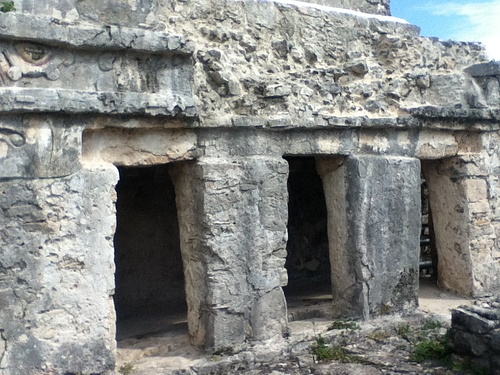
The Temple of the Frescoes gets its name from paintings on the interior walls depicting Chaac and Ix Chel in the presence of the Descending God. Although these works of Maya art can no longer be seen by visitors, the exterior of the building is impressive enough. You need to give yourself adequate time here, as at every structure, because the buildings are a story told in stone.
The cornice I am looking at, for example, is the face of the god but quite easy to miss if you are in too great a hurry. All of the buildings at Tulum are roped off now, a fairly recent development necessary for the preservation of the site, but one can still stand close enough to be able to appreciate the intricate artwork and the kind of effort which must have gone into the construction and ornamentation of each building.
Temple of the Descending God & El Castillo
Turning down the next narrow avenue, between other ruins, El Castillo rises up on the right, but you do not want to get there too quickly; there is another treasure to see. At the end of the path you turn right and the Temple of the Descending God sits up on the hill toward your left. Inside this temple is a mural, quite beautiful, as well as more red handprints on the walls. Not that many years ago, you could go in, but the building is now roped off at a distance from the path. You can no longer get close to it at all but can still see the Descending God carved over the doorway.
Directly past this temple is El Castillo. The architecture of the late Maya period has often been criticized as less impressive than Classic structures like Chichen Itza or Uxmal, but I have never understood those complaints. El Castillo shows perfect balance and a skill that is equal to or surpasses European structures of the same period. You can walk around the building but at a considerable distance. Rounding the back, you look out toward the sea and down toward a small white beach below the cliff.
This would have been where Maya traders would have docked their small craft to come ashore. Tulum was the trading hub of a number of important Late Period cities from as far away as Xicalango on the other side of the peninsula to Mayapan in the north, Cozumel to the east, Lamanai to the far south, and the city of Naco even further down the coast. Tulum grew wealthy from this trade, and it was this thriving city the Spanish first encountered when they arrived in the 16th century CE and, just as at Tantun Cuzamil, brought Christianity and smallpox which would both destroy and reshape the lives of the indigenous people.
Conclusion
The wind blows warmly from the sea, and I turn to look up at the back of El Castillo and then again out toward the water. I imagine the small boats of the Maya approaching the beach and the people on land calling to each other to come and meet the merchants. Again, I find, there is too little time to stay and enjoy the site, although I realize we have been here for over three hours. We make our way out through an exit on the far side of the city from where we entered and start back down the path.
I find myself thinking of the red handprints here and at Tantun Cuzamil and realize I will remember these more than any of the other sights I have seen today. The ruins are magnificent but there is something so intimate about the handprints, as though someone left a note for each future visitor which resonates through time.
At some point in the past, someone went to the effort to climb up that wall and leave a lasting memory of their existence. Human beings have an innate need to be remembered, to endure beyond death in the memory of the living, sometimes expressed in great deeds or monuments but equally in simple handprints pressed onto a wall in the hope someone in the future would notice and remember them – not even by name – but just by that simple and universally understandable gesture of making even the smallest mark saying, “I was here”.
